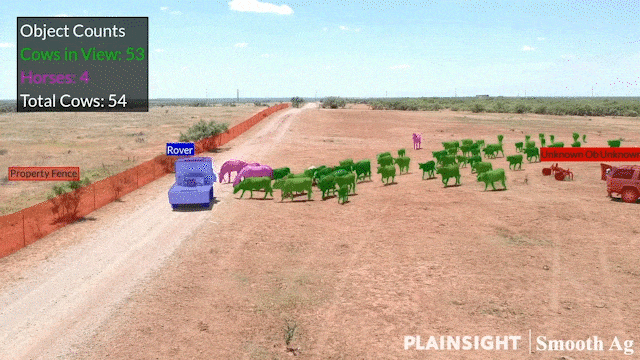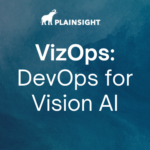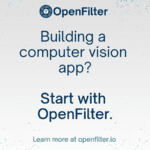Last time on AI in Plainsight, I spoke to Smooth Ag’s CEO, River McTasney, and Head of Corporate Development, Hunter Allemand about the origins of their business, the capabilities of their autonomous Ranch Rover, and computer vision’s power to drive additional AgTech innovation. In the conclusion to our discussion, we dig deeper into computer vision’s growing role in transforming the lives of ranchers and farmers.
Bennett Glace: Welcome back to AI in Plainsight and Part 2 of my conversation with River McTasney and Hunter Allemand, Smooth Ag’s CEO and Head of Corporate Development. Last week we discussed Smooth Ag’s origins and the technology in its repertoire. This time around, you’ll hear about how Plainsight’s partnership with Smooth Ag got started and how computer vision will help shape the future of AgTech.
Could you speak a little more to how Plainsight came into the picture and what the addition of computer vision means for the Rover? What kind of additional use cases or challenges does this address for ranchers?
Hunter Allemand: I’m an adamant LinkedIn user and one day I guess the algorithm played in y’alls favor. I saw the sheep counting video and just knew we had to have a conversation. I’m a guerilla warfare strategist when it comes to social media. If there’s a CEO who doesn’t require you to put in their email to connect and I need to talk to them, I’ll do it. And that’s what I did. I just reached out to Carlos and sent him some pictures and a link to our website. My angle was this deployment in the dirt perspective. I loved what you were doing and wanted to provide more deployment options. And it worked out, right? River and I were told by somebody to avoid walking in the footsteps of giants. And they meant that from a developmental standpoint. If there are people out there who have created solutions, it’s all about integrating and I think we’re gonna see that more in the future of this partnership ecosystem. To scale quickly and deliver the best results to our customers, we want to work with the best people solving the same problems we’re looking at. That’s how Plainsight came across. You go to your website, you see you’ve worked with JBS, you’ve got that sheep video. There was a clear cultural and industrial alignment.
River McTasney: I’ll touch on the second part of your question – how is it good for the rancher? I think it goes back to optimization of labor. So something I want to go back to on this, back to the previous question a little bit, is the opportunity cost that comes with something like this. Let’s say it takes you three hours to run your feed route and you’re running that feed route for multiple reasons. One of those reasons is to actually lay eyes on your livestock assets. That’s to check their health, check on the calves, make sure they all come up, make sure there’s none you need to go look for, know, they haven’t come up three days in a row now, so probably need to go look for ’em, right? And you gotta keep track. That’s something Hunter brought up earlier. Are we ever going to get to the point where we’ve removed people from feeding? No, but we’re definitely going to see a gap. Ranchers will find there are times that they don’t need to be there, instead of going out to feed five times a week, maybe they’ll go out once. So, there’s still the human touch and the human eye, but it’s gonna be nice those other four times to get visual data without having to be there. That’s one way it directly helps the rancher. We can pull it up on our phone and feel confident enough to go out there just once a week. And then, we have to look at it from a long-term results perspective. We’re constantly collecting data and crunching it. Over time, we’re gonna be able to do things like body condition scoring and make an average of the herd. We’re gonna be able to see when calves drop at different times. We’ll be able to throw in pasture data. As you drive certain stretches of certain pastures, you’ll ben able to look at all that forage and after 10 years that data is going to be really important and you’re gonna be able to go back and look at all the different forage levels and the climate and everything else. So, that’s the gist of how it’ll help ranchers in the immediate and long term. And I think we’re gonna see a lot of good come out of that. Hunter, anything to add?
HA: On the subject of that data visualization over time, I think it’s important for maybe the less ranch-experienced people to understand that when it comes time for someone to take the reins at a ranch all they can lean on is experience. There isn’t a massive data archive to help understand what weather will do to the bottom line or how a bad year can affect the herd. As we’re looking over multi-generational timelines, let’s say 25 or 30 years, without data, they’ve just gotta wing it. With data, we’re starting to realize that the new era of ranchers will be able to take this data and really understand how to optimize their ranches. I think that’s what we see as the really exciting piece to this, unlocking the ranchers’ capabilities. Instead of just reporting a bad year, they’ll be able to quantify just how bad a year it was. That’s the most important thing as we’re looking at climate change and its impacts on the weather. Drier years are getting drier, wetter years are getting wetter. We wanna know what that does to the herd, what it does to the ranch. You can’t do that in a notebook. This data has to be collected digitally and synthesized in a way that creates results.
RM: People may ask, why are we collecting this data now because there’s been no solution to piggy-back the data collection off. There have been lots of write-ups on providing robots to go out and collect this data, but they’re not solving a problem in a way that’s financially valuable for ranchers. What we’ve done here, this is a heavy payload platform. Adding the feeding aspect that’s started to provide enough value to get in there.
BG: My next question is related to something you’ve mentioned in the past, River. You’ve said that words like autonomous can send up instant red flags for a lot of professionals in the field. How do you address skepticism around technologies like the rover or computer vision in general?
RM: I think people have a poor understanding of what autonomy is. I think they go immediately to a manufacturing plant with a bunch of automated robots and no people there. But in an industry like agriculture, on cash crop farms, there’s a lot of autonomous technology there. All the tractors have an autonomous element to them. There’s still a person in the tractor. I think that’s where the world is, there’s a misperception about what autonomy means.
HA: I think that we’ve taken the word autonomous and really changed that up for our sales calls. We use the term augmented or augmentation because, like River said, the ranch or the farm is not a factory, it’s not a clean environment, and there aren’t specific roles. Joe the farmer or rancher has so many hats to wear. There’s no solving for that unless we had a humanoid robot capable of doing everything a person could do. There’s no replacing the rancher. It’s not an especially structured enterprise, he has to do a lot. And I think the word augmented really highlights exactly what autonomy is going to do for everybody’s efficiency and capability. We don’t want to get rid of jobs. We’ve identified that that’s not really possible and practical in a ranch setting. We realized that these people need help. And as you can see, the labor force situation is really tough. Neither of us are ranch hands, right? That’s not an exciting or financially lucrative position to be in and it’s tough for ranches of all sizes to fill it. It’s just not a high-ROI position to hire for so families often take on the brunt of that work. That keeps them wearing many hats. When we look at it, we always try to explain to our customers that this is a way to expand their capabilities and not a replacement for them, because that comes up so much. They do more than just feed cattle when they go out there and we understand that and I think that the way we explain it is this is a tool for your toolbox. When you’ve got a doctor’s appointment or big project that’s taking your focus, this is here to help you execute and continue without any bumps in the road.
BG: What would you say excites you most about the evolving role of AI in agriculture?
RM: Everything. It’s gonna be like automatically filling a spreadsheet with your eyes, right? ‘Oh that cow looks a little skinny today, this looks a little bad, that’s not looking too great.’ You’ve now got all that info without writing anything down. You didn’t attach a score or a quantifiable metric to it. We’ve never done that. Whenever you add some AI visualization to things, it’s doing all this work all the time. Every .1 seconds, or every five seconds, or every minute, or whatever, it’s constantly logging thousands of data points. And they’re really not that expensive in retrospect. We’re constantly logging data, the visualization only gets better, we’re only learning more and getting better at understanding what it’s telling us. I think that’s what’s really exciting about it.
HA: I agree with everything that River says in terms of what’s so exciting about it. If we look at all of the pieces of this puzzle – intense geopolitical environments, crazy climate change side effects, and an aging demographic who’s running ranches. I think people will be surprised to hear that the average age of a rancher is almost 60 years old now. And typically ranchers think it’s gonna be tough to convince a kid who’s a CPA making six figures to come back to the ranch with enthusiasm. What this is providing is an opportunity to make a ranch scalable within a family unit. You don’t have to give up on your passions. Maybe you’re not passionate about ranching, but you can use autonomy to augment your capabilities to run the ranch and make it so much easier. And as we look at a growing population, we’ve really gotta start supplementing our capabilities to get work done and provide food to all those people. That’s where all the growth comes from. Bringing technology to the forefront is going to allow us to produce more, more efficiently, and more safely for humans and animals. Like River said, even if you take notes and you say, ‘Cow 32 looked pretty rough today.’ Changes over the following days are probably going to be marginal. Unless it’s catastrophic. If a cow drops dead, obviously something was wrong, but if you’re getting insights from vision AI you’re able to really hone in on that and pick up some of those small, minute changes. All of the sudden, you’re seeing the benefit for the animal. You’re not just guessing or shooting in the dark anymore. We’re using data to provide results.
BG: Thanks again to River and Hunter from Smooth Ag and thanks for listening to another episode of AI in Plainsight. We’ll see you next time.
Learn More About Computer Vision for Agriculture
For more podcast episodes, updates from the Plainsight team and news from the worlds of AI, ML, and Computer Vision delivered directly to your inbox, make sure to subscribe to our AI Week in Review newsletter on LinkedIn. If you’re ready to learn how Plainsight can make computer vision the catalyst for your holistic digital transformation, request a call with our experts today.




